Do all of the following
You have been asked to clarify a number of matters for the board of directors of a major company that is considering a massive investment. The directors have decided that all major investments will be evaluated in terms of their net present value (NPV) and that NPV will be determined in a relevant and meaningful manner. Unfortunately, they cannot agree on the application of the best way to calculate NPV. The company has a beta coefficient of 1.6. It has a market capitalisation of E60 million. The company is financed entirely by equity. The directors believe that their high beta coefficient has depressed the market capitalisation and so they wish to invest in some new lines of business. The directors are considering an investment that will reduce the company's beta. They intend to borrow E20 million at an interest rate of 8%. They intend to invest the whole amount in a new business venture that is significantly different from the present business. This venture is in a business area where companies traditionally have beta coefficients of approximately 1.1, although the directors feel that the business is so different from the existing industry that there is an even greater diversification effect. The directors are considering evaluating the NPV of the investment in terms of the company's present cost of equity, although two members of the board believe that this rate is theoretically incorrect. One board member believes that the cost of equity will be affected by the investment and that it should be used in place of the present rate and another believes that the weighted average cost of capital, revised to allow for the fresh investment and the new borrowing, should be used. The risk free rate of returnis 4%. The market risk premiumis 6%. The company's effective tax rate is 28%. (i) Use the capital asset pricing model (CAPM) to: (a) Calculate the company's present cost of equity. (b) Estimate the company's ungeared beta, assuming that it proceeds with the investment. (c) Estimate the company's geared beta, assuming that it proceeds with the investment. (d) Determine the company's weighted average cost of capital to proceed with the investment, using the results of your other calculations and estimates. [8] (ii) (a) Discuss the appropriateness of the directors' decision to determine the NPV of the proposed investment in terms of one or other of the measures of the company's cost of capital. (b) State, with reasons, whether there is a more appropriate rate that should be used instead [6]Sarah recently inherited a substantial sum of money. Her friend Tom is a successful businessman who owns a small factory. Tom is a sole trader. He has offered Sarah the opportunity to become a sleeping partner in his business. She will invest E200,000 of her inheritance in return for a partnership share of 30% of all future profits. She will not take any part in the running of the business. The business is profitable and is struggling to keep up with demand, so the expansion will probably be successful. Describe the risks that Sarah will be taking on if she enters into this arrangement with Tom [5] A company's directors are considering issuing redeemable preference shares as an alternative to borrowing. They believe that the company is too close to its borrowing capacity and so equity is preferable to debt. Outline the implications for the company of issuing redeemable preference shares in these circumstances. [5] Explain why finance leases have to be accounted for on the basis that the asset and an associated liability must appear in the lessee's statement of financial position, even though the lessee does not own the asset. [5]Partan is a quoted company. The directors have asked for a report on the company's cost of capital. The following information has been provided: . The market capitalisation of the company's equity is E600 million. . The company has debentures with a face value of E250 million. Their market value is E220 million. . The corporation tax rate is 23%. The risk-free rate of interest is 4% per annum . The ungeared beta on Partan's equity is 1.3. . The debentures have a coupon rate of 5% and are redeemable at par in five years' time. . The market rate of return is 9% p.a. The directors have already calculated Partan's weighted average cost of capital (WACC), but they wish you to prepare a calculation in order to confirm their figures. They are concerned that the WACC is higher than they think is justified and they wish to discuss some proposals for reducing the figure because the directors plan to raise further finance in order to fund expansion, but they are unwilling to do so if the cost of capital is overstated. (i) Determine Partani's cost of equity using the company's geared beta. [4] (ii) Determine Partan's approximate cost of debt. [4] (iii) Calculate Partan's WACC. [2] The marketing director has suggested that the company could dramatically reduce the cost of capital if the board promotes the company in the same way that it promotes its products. The directors should identify the market's needs and explain to those who provide finance just how well suited Partan is to meeting those needs. (iv) Discuss the logic of the marketing director's proposal for reducing the WACC. [10] [Total 20]









